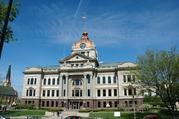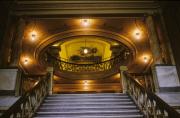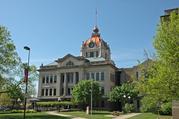100 S. Jefferson St.
| Historic Name: | Brown County Courthouse |
|---|---|
| Reference Number: | 76000053 |
| Location (Address): | 100 S. Jefferson St. |
|---|---|
| County: | Brown |
| City/Village: | Green Bay |
| Township: |
| Brown County Courthouse 100 South Jefferson Street, Green Bay, Brown County Date of construction: 1908-1911 Architect: Charles E. Bell In 1911, an eastern newspaper wrote that Brown County's newly constructed courthouse was the "grandest courthouse in the west". With impressive architecture and interesting art, it is no wonder that the press praised the building by Minneapolis based architect, Charles E. Bell, who also designed the capitols of Montana and South Dakota. The three-story courthouse is of the Beaux Arts style which was popular prior to World War I. Beaux Arts buildings display more elaborate ornamentation than pure Neoclassical structures, although both draw inspiration from classical architecture. The courthouse, faced with Marquette raindrop stone, has a copper-covered dome, bell, and clock tower which houses an original Seth Thomas clock. The art displayed at the Brown County Courthouse is as impressive as its architecture. In 1910, Milwaukee based artist Franz Rohrbeck painted various murals inside the courthouse. One depicted the landing of Jean Nicolet, the area¿s first European explorer, in 1634. Other murals depict battles, the American military base at Fort Howard, and the arrival of missionary Father Claude Allouez in the company of an Indian Chief. He painted the dome with the themes Justice, Agriculture, Commerce, and Industry. A statue depicting French explorer Nicolas Perrot, Jesuit missionary Father Claude Allouez, and a Native American stands just outside the courthouse. Sculptor Sidney Bedore completed this sculpture, "Spirit of the Northwest," in 1922. Green Bay is where Wisconsin's first Europeans settled. Originally home to Woodland Indian tribes, the first Europeans came to the area via the Fox River in 1634. Soon thereafter, many French voyagers, fur trappers, and Jesuit missionaries came to what they called "La Baie des Puants" (The Bay of the Stinking Water) and "La Baie Verte"(Green Bay). By the late 1840s, when Wisconsin became a state, the lumber trade started to prosper in Green Bay. It was at this time that many Belgian, German, Scandinavian, Irish, and Dutch immigrants settled to farm the fertile soil of the area. Today the paper industry flourishes in Green Bay. The Courthouse is open to the public during regular business hours. |
| Period of Significance: | 1900-1924 |
|---|---|
| Area of Significance: | Architecture |
| Area of Significance: | Art |
| Applicable Criteria: | Architecture/Engineering |
| Historic Use: | Government: Courthouse |
| Architectural Style: | Beaux Arts |
| Resource Type: | Building |
| Architect: | Bell,C.E. |
| Historic Status: | Listed in the National Register |
|---|---|
| Historic Status: | Listed in the State Register |
| National Register Listing Date: | 01/01/1976 |
| State Register Listing Date: | 01/01/1989 |
| Number of Contributing Buildings: | 1 |
|---|---|
| Number of Contributing Sites: | 0 |
| Number of Contributing Structures: | 0 |
| Number of Contributing Objects: | 1 |
| Number of Non-Contributing Sites: | 0 |
| Number of Non-Contributing Structures: | 0 |
| Number of Non-Contributing Objects: | 0 |
| National Register and State Register of Historic Places, State Historic Preservation Office, Wisconsin Historical Society, Madison, Wisconsin |





